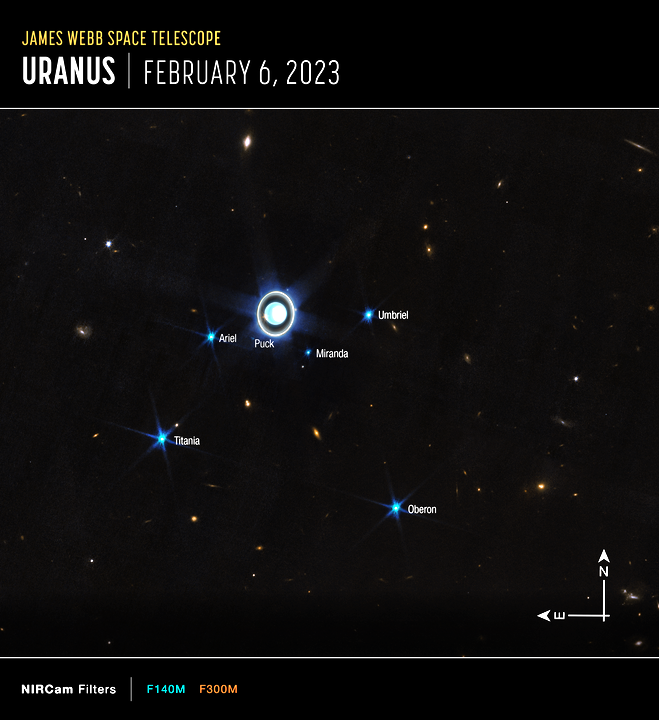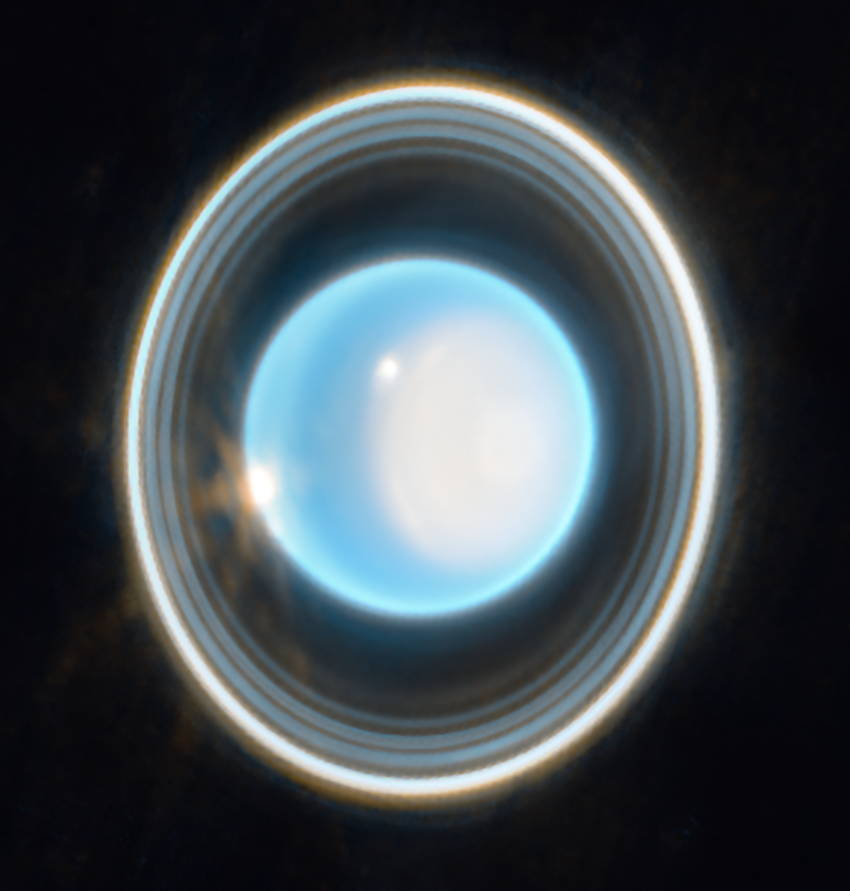A Journey into the Complex Atmosphere, Rings, and Moons of an Ice Giant
Building on the success of the captivating Neptune image unveiled in 2022, NASA’s James Webb Space Telescope has captured a mesmerizing view of the solar system’s other ice giant, Uranus. This striking image showcases the planet’s striking rings and vivid atmospheric features. The Webb data underscores the observatory’s unparalleled sensitivity to the most elusive dusty rings, which have been imaged by only two other establishments: the Voyager 2 spacecraft during its 1986 flyby, and the Keck Observatory employing cutting-edge adaptive optics.
The Peculiar Tilt of Uranus: Exploring the Ice Giant’s Unusual Rotation Axis
Uranus, the seventh planet from the Sun, boasts a unique feature: its rotation axis is tilted at an approximate 90-degree angle relative to the plane of its orbit. This orientation results in extreme seasonal variations, as the planet’s poles endure years of continuous sunlight followed by an equal duration of complete darkness. With an orbital period of 84 years, Uranus is currently in late spring in its northern pole, which is visible in the image. The northern summer will arrive in 2028. In contrast, during Voyager 2’s visit, the southern pole was experiencing summer. Presently, the southern pole lies on the planet’s ‘dark side,’ hidden from view and facing the void of space.
This infrared image, captured by Webb’s Near-Infrared Camera (NIRCam), combines data from two filters at 1.4 and 3.0 microns, represented here in blue and orange, respectively. The resulting representative-color image exhibits a distinct blue hue.
Voyager 2’s observations of Uranus depicted an almost featureless blue-green sphere in visible wavelengths. However, the infrared wavelengths and enhanced sensitivity of Webb provide a more detailed view, revealing the dynamic nature of Uranus’s atmosphere.
On the sunlit side of the planet, a brightening area at the pole, called a polar cap, is visible. This polar cap is exclusive to Uranus, appearing when the pole is exposed to direct sunlight during the summer and disappearing in the fall. The Webb data will help scientists unravel the enigmatic mechanism behind this phenomenon. Webb has also disclosed an unexpected aspect of the polar cap: a subtle enhanced brightening at the cap’s center. The sensitivity and longer wavelengths of Webb’s NIRCam could be the reason why this amplified polar feature is more evident than in images from other powerful telescopes, such as the Hubble Space Telescope and Keck Observatory.
Bordering the polar cap is a luminous cloud, accompanied by several fainter extended features just beyond the cap’s edge, and a second remarkably bright cloud appears at the planet’s left limb. These clouds are typical for Uranus in infrared wavelengths and are likely linked to storm activity.
Uranus is classified as an ice giant due to the composition of its interior. The majority of its mass is believed to be a hot, dense fluid consisting of “icy” materials—water, methane, and ammonia—situated above a small rocky core.
This Webb image reveals 11 of Uranus’s 13 known rings. Some rings appear so vivid with Webb that they seem to merge into a larger ring when positioned closely together. Of these, nine are considered the planet’s primary rings, while two are fainter, dusty rings (such as the diffuse zeta ring nearest to the planet) that were discovered during Voyager 2’s 1986 flyby. Scientists anticipate that future Webb images of Uranus will unveil the two faint outer rings identified by Hubble during the 2007 ring-plane crossing.
Webb also captured several of Uranus’s 27 known moons (although most are too small and dim to be visible here); the six brightest are labeled in the wide-view image. This brief, 12-minute exposure of Uranus using just two filters represents only a fraction of Webb’s capabilities when observing this enigmatic planet. In 2022, the National Academies of Sciences, Engineering, and Medicine designated Uranus science as a priority in its 2023-2033 Planetary Science and Astrobiology Decadal Survey. Additional Uranus studies are currently underway, with more planned during Webb’s inaugural year of scientific operations.
The James Webb Space Telescope stands as the world’s leading space science observatory. Webb aims to unravel mysteries within our solar system, explore distant worlds orbiting other stars, and investigate the enigmatic structures and origins of our universe and our place within it. Webb represents an international collaboration led by NASA, in partnership with ESA (European Space Agency) and the Canadian Space Agency.
The Promise of James Webb Space Telescope
This remarkable image of Uranus captured by the James Webb Space Telescope not only enhances our understanding of the ice giant but also serves as a testament to the exceptional capabilities of the observatory. As we continue to explore the solar system, Webb will play a crucial role in advancing our knowledge of planets, moons, and other celestial bodies. The telescope’s keen sensitivity and unique ability to capture data in various wavelengths will enable scientists to make groundbreaking discoveries, as evidenced by the incredible details seen in the Uranus image. This is just the beginning of a new era in space exploration, and the James Webb Space Telescope promises to unveil the countless mysteries that lie hidden within our vast and wondrous universe.
Discovery of Uranus
The discovery of Uranus marks an important milestone in the history of astronomy, as it was the first planet discovered using a telescope. The planet was found by the British astronomer Sir William Herschel on March 13, 1781. Uranus is the seventh planet from the Sun and was the first planet discovered beyond the orbit of Saturn, which had been known since ancient times.
William Herschel, a talented musician and amateur astronomer, was observing the night sky from his garden in Bath, England, when he noticed an object that appeared to be a faint star. Intrigued by its unusual appearance and motion, Herschel initially believed it to be a comet. However, after further observations and calculations, he and other astronomers concluded that the object was, in fact, a new planet.
The discovery of Uranus expanded the known boundaries of our solar system and demonstrated that there might be more undiscovered celestial objects beyond what was visible to the naked eye. Herschel’s find also highlighted the importance of telescopic observations in the field of astronomy.
Naming the newly discovered planet proved to be a point of contention among astronomers. Herschel initially proposed naming it “Georgium Sidus” (George’s Star) in honor of King George III of Great Britain. However, the international astronomical community did not readily accept this name. Instead, they eventually agreed on the name “Uranus,” following the tradition of naming planets after Roman gods. Uranus is the Latinized version of the Greek god of the sky, Ouranos, maintaining consistency with the mythological theme of the other known planets’ names.
Discovery of Neptune
(Bonus) The discovery of Neptune is an intriguing story that combines mathematics, astronomy, and international collaboration. Neptune is the eighth and farthest known planet from the Sun in our solar system. It was discovered on September 23, 1846, by German astronomer Johann Gottfried Galle, but its existence had been predicted mathematically before it was observed through a telescope.
The story begins with the observation of irregularities in the orbit of Uranus, which had been discovered in 1781 by William Herschel. Astronomers in the early 19th century noticed that Uranus’s observed position did not match the position predicted by Newton’s laws of motion. These discrepancies led them to believe that the gravitational pull of an undiscovered planet was affecting Uranus’s orbit.
Two brilliant mathematicians, Frenchman Urbain Le Verrier and British astronomer John Couch Adams, independently started working on the problem. They each used the observed data on Uranus’s orbit and applied the laws of celestial mechanics to calculate the potential position of this hypothetical planet. Although they had never met, their calculations were remarkably similar.
Le Verrier communicated his findings to the Berlin Observatory, where Johann Gottfried Galle received the information. On the night of September 23, 1846, Galle and his assistant Heinrich Louis d’Arrest pointed their telescope to the location predicted by Le Verrier and discovered Neptune within just one degree of the predicted position. This incredible discovery was a testament to the power of mathematics and the accuracy of Newton’s laws of motion in predicting the existence of celestial bodies.
Since the discovery was based on the work of multiple astronomers and mathematicians from different countries, the credit for the discovery of Neptune is often shared among Adams, Le Verrier, and Galle.
Image 1:
(Feature Image) In this close-up image of Uranus, taken by Webb’s Near-Infrared Camera (NIRCam) on February 6, 2023, the planet’s rings are displayed in striking detail. The representative-color image showcases a blue hue, achieved by merging data from two filters (F140M, F300M) at 1.4 and 3.0 microns, depicted as blue and orange.
On the right side of the planet, a brightening area near the pole facing the Sun forms a distinct polar cap. This feature is exclusive to Uranus, as it is the only planet in the solar system with an extreme tilt, causing its dramatic seasonal variations. Webb’s observations unveil a subtle enhanced brightness near the Uranian north pole.
Bordering the polar cap, a luminous cloud is accompanied by several fainter extended features just northward of the cap’s edge, while a second remarkably bright cloud appears at the planet’s left limb. These clouds, characteristic of Uranus in infrared wavelengths, are likely linked to storm activity.
The zoomed-in image of Uranus, taken by Webb’s Near-Infrared Camera (NIRCam) on February 6, 2023, offers spectacular views of the planet’s rings. The representative-color image, displaying a blue hue, is created by combining data from two filters (F140M, F300M) at 1.4 and 3.0 microns, represented as blue and orange. Image credits go to NASA, ESA, CSA, STScI, with processing by J. DePasquale (STScI).
Image 2:


